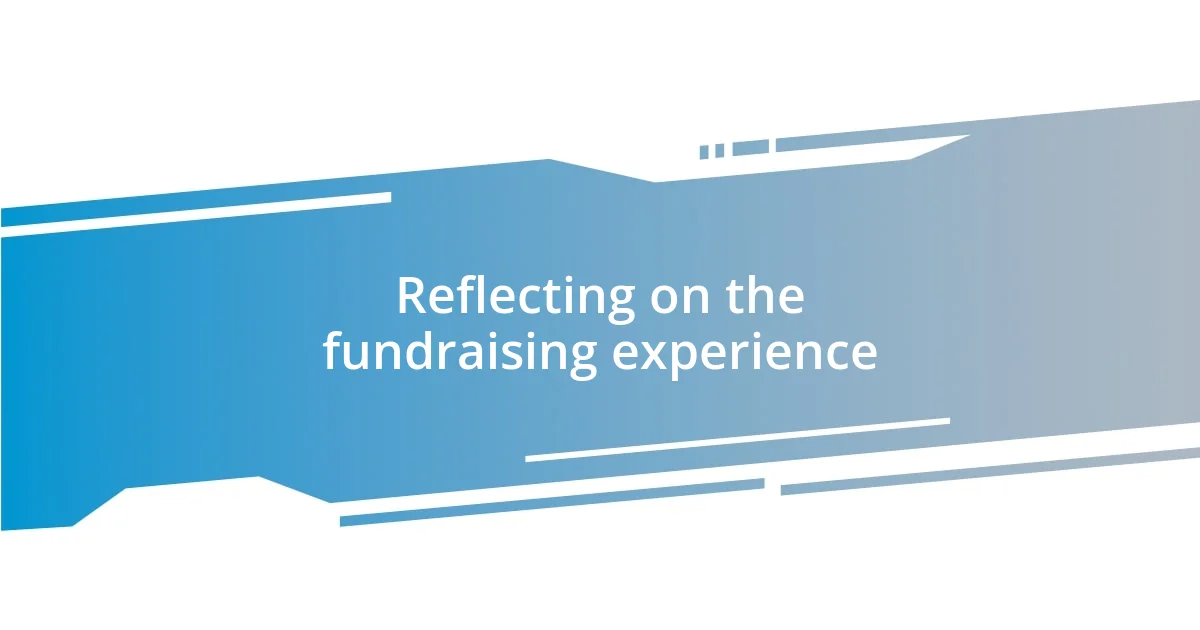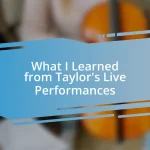Key takeaways:
- Understanding the diverse needs of disaster-affected communities is crucial, encompassing both physical and emotional support.
- Choosing effective fundraising methods and setting clear, flexible goals enhances community engagement and the overall impact of relief efforts.
- Reflecting on the fundraising experience fosters gratitude and connection, emphasizing the power of collective empathy and ongoing relationships with contributors.

Understanding disaster relief needs
When a disaster strikes, understanding the immediate and long-term needs of affected communities is crucial. I remember the chaos after a hurricane hit my town; families were left without shelter, food, or even clean water. How do you prioritize when every need seems urgent? That’s often the struggle for relief organizations, who must assess which resources will have the greatest impact first.
I recall volunteering at a local shelter shortly after a massive flood. Besides food and water, emotional support became unexpectedly vital for those affected. The fear and uncertainty in people’s eyes were palpable. It’s easy to overlook mental health in disaster relief, but isn’t it just as important as providing physical necessities? Engaging with survivors taught me that addressing their emotional wounds was often as critical as meeting their material needs.
Understanding a community’s specific circumstances is essential for effective disaster relief. Each disaster is different, and what works in one area may not resonate in another. For example, during wildfires, the immediate need might focus on evacuation and safety, yet the long-term recovery could hinge on restoring livelihoods. How can we ensure our efforts are both timely and relevant? It requires ongoing dialogue with the affected communities, allowing their voices and experiences to shape our response.

Choosing the right fundraising method
Choosing the right fundraising method can significantly influence the effectiveness of disaster relief efforts. From my experience, it’s essential to align your approach with both the urgent needs of the community and your available resources. I once organized a community bake sale for a local disaster response initiative, and while it was simple, we gathered enough funds to support a family in distress. It reminded me that even small, grassroots efforts can lead to meaningful contributions.
Here are some popular fundraising methods that resonate well with communities:
- Crowdfunding platforms—like GoFundMe or Kickstarter—allow for rapid contributions online.
- Community events—these can be anything from bake sales to charity runs, encouraging participation and connection.
- Social media campaigns—leveraging platforms like Facebook or Instagram to spread awareness and drive donations.
- Corporate sponsorships—partnering with local businesses can amplify your reach and financial backing.
- Direct donations—setting up a simple online payment method can facilitate smoother contributions.
Understanding the strengths and limitations of each method is vital, as I learned when exploring local options versus national campaigns—each offered unique benefits and challenges. Selecting the best fundraising strategy can ultimately make a profound difference in the support extended to those in need.

Setting clear fundraising goals
Setting clear fundraising goals is about knowing exactly what you want to achieve before you start your campaign. I remember the first time I set a fundraising target for disaster relief; it felt daunting. But once I outlined a specific amount and rationale behind it, everything fell into place. I aimed to collect $5,000 to provide hygiene kits for affected families, and having that clear goal streamlined our efforts and motivated the team.
When goals are defined, it becomes easier to measure success. For instance, in one campaign, I tracked every donation, no matter how small, revealing patterns that helped us adjust our approach. It became a thrilling challenge to see how close we were to that initial target! Having tangible milestones made our progress feel real and energizing, sparking engagement from our community every step of the way. A clear goal can transform a vague ambition into a shared mission.
At the same time, I learned the importance of adaptability. Sometimes, despite our meticulous planning, unexpected situations arose, like a sudden increase in need after another disaster. Being flexible with our goals allowed us to shift our focus without losing momentum. It’s about setting that initial direction while being open to change as circumstances evolve.
| Key Element | Example |
|---|---|
| Specific Target | $5,000 for hygiene kits |
| Measurable Milestones | Tracking donations regularly |
| Community Engagement | Involving locals in events |
| Flexibility | Adjusting goals based on new needs |

Engaging with your community
Engaging with your community is truly the heartbeat of any successful fundraising campaign. When I started my fundraising journey, I thought about the kind of community I wanted to reach out to. I remember organizing a local meeting where I simply shared my vision—a casual gathering in a cozy café that sparked genuine interest and collaboration. Hasn’t it been fascinating to see how people can unite over a shared cause? Everyone left that night more energized and connected, invigorated by a common purpose.
As I dove deeper into building those relationships, I utilized social media not just for fundraising updates but also to share stories that resonated with our goals. One post highlighted a family that had lost everything, paired with an emotional photo that captured their resilience. The outpouring of support was humbling; people didn’t just donate; they interacted, shared their thoughts, and even offered to help physically with collections. Engaging on that personal level made all the difference; it made everyone feel like they were part of the solution rather than just passive donors.
I often wonder about the untapped potential in every community to do good. When we come together, each voice adds strength to the collective impact. At a community picnic I organized, we incorporated fun activities alongside sharing stories from those affected by the disaster. The joy in the air was palpable, and it reminded me that fundraising could be both impactful and enjoyable. By fostering connections, I realized we could build a support system that extended far beyond that initial fundraising goal. It was about creating relationships that would last way beyond our efforts, fueling a culture of compassion and action.

Promoting your fundraising efforts
Promoting your fundraising efforts is essential for reaching a wider audience. I remember the rush I felt when I first created a campaign page on social media. I was nervous about hitting “publish,” but sharing every detail made it real. I vividly recall how my first post reached not only friends but their friends as well—a ripple effect I hadn’t anticipated. Have you ever been surprised by how far a simple message can travel? It’s exhilarating to see people rallying behind a cause you’re passionate about.
Utilizing various platforms served my efforts well. I made short videos sharing my personal experiences that drew a vivid picture of the disaster’s impact. One clip showed me visiting a local shelter, speaking with families who had lost everything. The raw emotions in that video prompted heartfelt responses from viewers, resulting in conversations and donations. I learned that visuals combined with genuine storytelling can create a compelling narrative that encourages more people to join your mission.
Incorporating local events into the mix was another game changer. Hosting a bake sale not only raised funds but generated buzz around our fundraising efforts. I’ll never forget the sense of community that gathered in that park on a sunny Saturday. People chatted, shared cookies, and learned about our cause—all while feeling like they were part of something bigger. Isn’t it amazing how fundraising can foster connections? By blending personal engagement with a variety of promotional strategies, I watched our fundraising blossom into a movement, making a meaningful difference in the lives of those who needed it most.

Tracking and reporting contributions
Tracking contributions can feel daunting, but I found that a structured approach makes it manageable. I remember setting up a simple spreadsheet that listed every donation alongside the donor’s name and a note of appreciation. Each time a new entry came in, I felt a rush of gratitude. It was like collecting little letters of hope, each representing someone’s belief in our cause.
Regular updates were crucial. I sent out weekly summaries to all contributors, detailing how their donations were making an impact. One week, I shared a story about a family who received the supplies they desperately needed, and I could almost feel the warmth of their gratitude echoing through my words. When donors see exactly where their money is going, it deepens their connection to our mission. Does that increased engagement not broaden the sense of community we’re cultivating?
I also learned the importance of transparency in this process. After a fundraising drive, I published a detailed report highlighting how funds were allocated—people appreciated the honesty. In one instance, a significant donor reached out after reading the report, expressing their desire to support our next project. That kind of engagement is invaluable. Tracking contributions isn’t just about the numbers; it’s about nurturing relationships and fostering trust, which ultimately fuels ongoing support for future initiatives.

Reflecting on the fundraising experience
Reflecting on the fundraising experience has been a journey of emotions and revelations. I still remember how, as the campaign gained momentum, I found myself overwhelmed with gratitude and a sense of responsibility. Each donation felt like a personal commitment, and I often wondered how to honor the faith people placed in me. Have you felt that weight of expectation when rallying support for a cause? It’s poignant to realize that every person giving their time or money is investing their trust in you.
One of the most profound moments I experienced came during a live fundraising event. As I shared stories from affected families, I could see the audience’s reactions; some wiped away tears, while others nodded in silent agreement, feeling the urgency of our shared mission. There’s something beautifully raw in witnessing collective empathy in action. It struck me then how fundraising transcends monetary contributions—it fosters a community united by compassion. Have you ever felt that powerful sense of alignment with others, all driven by a shared purpose? It’s an indescribable bond.
Looking back now, I appreciate how these experiences shaped my understanding of resilience. The kind words and encouragement I received reminded me that this work isn’t solitary; it’s a tapestry woven with diverse threads of support. There were moments of doubt, but in each challenge, I discovered new strengths, both in myself and in those around me. How remarkable is it that, through our struggles, we can uplift one another? The fundraising journey is less about hitting targets and more about the stories we carry forward—stories of hope, connection, and a shared commitment to making a difference.














